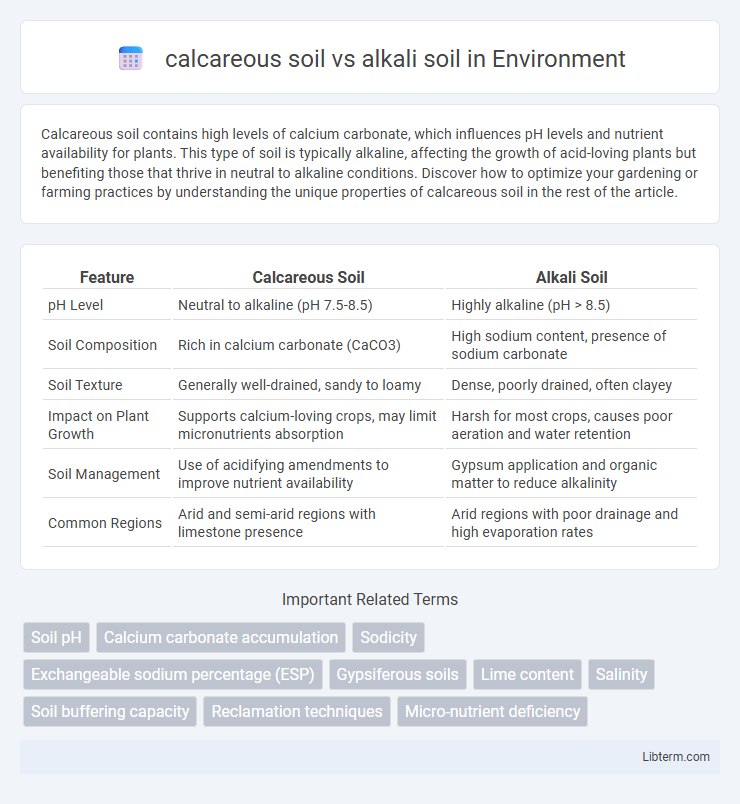Calcareous soil contains high levels of calcium carbonate, which influences pH levels and nutrient availability for plants. This type of soil is typically alkaline, affecting the growth of acid-loving plants but benefiting those that thrive in neutral to alkaline conditions. Discover how to optimize your gardening or farming practices by understanding the unique properties of calcareous soil in the rest of the article.
Table of Comparison
| Feature | Calcareous Soil | Alkali Soil |
|---|---|---|
| pH Level | Neutral to alkaline (pH 7.5-8.5) | Highly alkaline (pH > 8.5) |
| Soil Composition | Rich in calcium carbonate (CaCO3) | High sodium content, presence of sodium carbonate |
| Soil Texture | Generally well-drained, sandy to loamy | Dense, poorly drained, often clayey |
| Impact on Plant Growth | Supports calcium-loving crops, may limit micronutrients absorption | Harsh for most crops, causes poor aeration and water retention |
| Soil Management | Use of acidifying amendments to improve nutrient availability | Gypsum application and organic matter to reduce alkalinity |
| Common Regions | Arid and semi-arid regions with limestone presence | Arid regions with poor drainage and high evaporation rates |
Definition of Calcareous Soil
Calcareous soil is characterized by its high calcium carbonate content, typically above 20%, which results in an alkaline pH level often exceeding 7.5. This soil type has poor nutrient availability due to calcium binding with phosphorus and micronutrients, limiting plant growth. In contrast, alkali soil contains high sodium levels, leading to soil dispersion and poor structure, markedly different from the calcium-driven characteristics of calcareous soil.
Definition of Alkali Soil
Alkali soil, also known as sodic soil, is characterized by high pH levels above 8.5 and excessive sodium content, which negatively affects soil structure and plant growth. Unlike calcareous soil, which contains high calcium carbonate and appears alkaline but retains good fertility, alkali soil suffers from poor drainage, reduced permeability, and impaired nutrient availability due to sodium saturation. Managing alkali soil requires gypsum application and proper irrigation to reclaim soil health and restore agricultural productivity.
Key Differences Between Calcareous and Alkali Soils
Calcareous soil is characterized by high calcium carbonate content, resulting in a neutral to alkaline pH and good drainage, whereas alkali soil contains excessive sodium salts, causing poor structure and high pH levels harmful to plant growth. Calcareous soil typically supports crops tolerant to calcium-rich conditions, while alkali soil requires reclamation practices to reduce sodium content for effective cultivation. Soil management strategies differ significantly as calcareous soil benefits from organic matter addition to improve nutrient availability, whereas alkali soil demands gypsum application and proper irrigation to restore soil fertility.
Chemical Composition and Properties
Calcareous soil contains high levels of calcium carbonate, resulting in an alkaline pH typically above 7.5, with poor solubility of phosphates and micronutrients like iron and zinc. Alkali soil, characterized by elevated sodium content and a pH above 8.5, presents poor soil structure due to dispersion of clay particles and reduced permeability. Both soils impact nutrient availability and crop growth, requiring specific management practices to improve fertility and soil health.
Origin and Formation Processes
Calcareous soil forms primarily from the accumulation of calcium carbonate derived from the weathering of limestone and other calcareous rocks in arid or semi-arid climates. Alkali soil results from prolonged evaporation in poorly drained areas leading to the accumulation of soluble salts like sodium carbonate on the soil surface. The contrasting origin lies in calcareous soil's mineral-rich parent material versus alkali soil's salt concentration due to groundwater discharge and salt leaching imbalance.
Impact on Plant Growth
Calcareous soil, characterized by high calcium carbonate content and alkaline pH, often leads to nutrient deficiencies like iron chlorosis, hindering plant growth. Alkali soil, with excessive sodium salts and pH above 8.5, causes poor soil structure and reduced water infiltration, restricting root development and nutrient uptake. Both soil types negatively impact plant health by limiting the availability of essential nutrients and altering soil physical properties.
Soil pH and Nutrient Availability
Calcareous soil typically features a pH range of 7.0 to 8.5, resulting from high calcium carbonate content that limits the availability of micronutrients like iron, zinc, and phosphorus. Alkali soil exhibits a higher pH, often above 8.5, caused by excessive sodium ions, which reduces nutrient solubility and impairs plant uptake of essential elements such as nitrogen, potassium, and magnesium. Effective management of both soil types requires pH adjustment and nutrient supplementation to enhance nutrient availability and improve crop productivity.
Management and Reclamation Practices
Calcareous soil management involves the application of elemental sulfur or gypsum to reduce alkalinity and improve nutrient availability, while ensuring proper irrigation to avoid salt buildup. Alkali soil reclamation requires the incorporation of gypsum followed by thorough leaching with good-quality water to displace sodium ions and restore soil structure. Both soils benefit from organic matter amendments to enhance microbial activity and improve soil texture, enabling better water retention and root penetration.
Common Crops Suited for Each Soil Type
Calcareous soil, rich in calcium carbonate and typically alkaline, supports crops like barley, wheat, cotton, and sugarcane that tolerate high pH levels and require good drainage. Alkali soil, characterized by high sodium content and poor permeability, is suitable for salt-tolerant crops such as barley, sorghum, and sugar beet, which can withstand saline conditions. Understanding the specific nutrient and pH requirements helps optimize crop selection for productive yields in these distinct soil environments.
Environmental Implications and Challenges
Calcareous soil, rich in calcium carbonate, often leads to nutrient imbalances, limiting the availability of essential elements like phosphorus and iron, which can hinder plant growth and reduce agricultural productivity. Alkali soil, characterized by high sodium content and elevated pH levels, causes soil structure degradation, water infiltration issues, and toxicity effects on crops, posing significant challenges for sustainable land management. Both soil types contribute to reduced soil fertility and increased salinization risks, necessitating tailored reclamation strategies to mitigate environmental degradation.
calcareous soil Infographic

 libterm.com
libterm.com